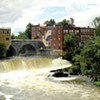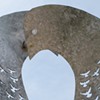Published April 27, 2016 at 10:00 a.m. | Updated May 3, 2016 at 8:21 p.m.
Nobody makes movies like "A Vermont Romance" anymore. Three-quarters of the way through the 1916 melodrama, the narrative skids to a halt. Will young lovers Dorothy and Jerry ever get together? Curious viewers learn the answer only after watching a highly detailed scene about ... the operations of a commercial bakery.
The Vermont-made silent film is unusual to modern eyes, yet it's highly representative of cinematic trends of a century ago. And that's why the Vermont International Film Foundation restored this key example of the state's filmmaking heritage. The improved version of "A Vermont Romance" makes the fourth stop on its statewide tour on Thursday, April 28, at Burlington's Main Street Landing Film House.
This is, in a sense, the third time the film has criss-crossed the state. One hundred years ago, it was shot at locations across Vermont; thereafter, it played at Vermont cinemas for months. The film's centenary tour is very much a homecoming.
Orly Yadin, executive director of VTIFF, says the scene in the bakery — filmed at the Tip Top building in White River Junction — isn't quite as out of place as it may seem. She explains that "A Vermont Romance" was commissioned by the Vermont Advance newspaper, the mouthpiece of the Progressive Party (no relation to today's Progs). The central plank of the party's platform was, as Yadin puts it, "modernization and mechanization." The bakery scene was likely the newspaper's unsubtle way of encouraging Vermont viewers to grow beyond their rural roots by voting Progressive.
Oddly, the cast of "A Vermont Romance" was selected by popular vote. "[The Advance] decided to produce a film that would increase their readership ... by announcing a competition," Yadin says. "Anyone in Vermont who wanted to be a movie star could be nominated, and the person with the most votes would get to play the leading lady, the leading man and so on."
The winners of the contest were Dorothy Whipple and Jerry Hunt, who hailed from the decidedly un-Hollywoody burgs of Waterbury and Derby Line, respectively.
Though "Romance" began as a publicity stunt, it resonates with historical significance. The half-hour film was produced in just 10 days in the summer of 1916, yet the filmmakers managed to shoot in locations as scattered as Burlington, Rutland, St. Johnsbury and Clarendon Gorge. And though the film is fiction, it includes invaluable documentary footage of Vermont 100 years ago — the landscape, architecture, clothing and mannerisms.
The Vermont Movie Archive Project, a branch of VTIFF, spearheaded the restoration of "Romance." The goal of the nonprofit program is to restore, preserve, catalog and make publicly available films that were made in Vermont or by Vermonters. Funded in part by Burlington's Green Valley Media, VAMP has partnered for its film restoration projects with Middlebury's Vermont Folklife Center, the University of Vermont Special Collections Department and the Vermont Historical Society in Barre.
"A Vermont Romance" is the third film to be restored under VAMP auspices. The first was the short 1971 documentary "Chester Grimes," about a Vermont logger and his team of horses. The second was "Transformations," a short film made in the 1970s by a Vermont women's collective. With the restoration and roadshowing of "Romance," Yadin says, VTIFF hopes to raise awareness of VAMP's preservation mission. The Vermont International Film Festival in October will likewise highlight VAMP's efforts, she notes.
VAMP and the historical society evenly split the cost of this latest digital restoration, which was done by California-based company Electric Pictures. Grace McKay, a restoration specialist at the company, worked from a 50-year-old 16mm film print to produce the new 2K digital version, using analog and digital processes to clean and stabilize the film's images.
Films made in the 1910s were not shot at a single consistent speed (e.g., 24 frames per second), so, McKay explains in a phone interview, she had to determine the proper speed by observing actors' movements. "We retimed the whole thing to 20 frames per second to get as close as we could to the actual camera speed," she says. McKay also recreated the film's titles, using a battered 8mm print for reference.
No evidence survives of a score to accompany the film, says Yadin. So VTIFF commissioned a new one from Bob Merrill, a composer and musician who regularly accompanies silent films at Dartmouth College's Hopkins Center for the Arts.
Merrill acknowledges that his score had to do some heavy narrative lifting, as not all of the film's story elements are crystal clear. "I eventually came up with themes," he says. "One is for privilege, one is for yearning, one is for rural life and then, of course, one is for the bad guy."
Merrill's score will be included on VTIFF's upcoming Blu-ray and DVD releases of "A Vermont Romance"; he'll also accompany the film at the Burlington screening, and at showings in May in Brattleboro and Middlebury. A panel discussion will follow each screening. Participants at the Burlington show include Vermont film historian Steve Bissette, Andy Kolovos of the Folklife Center and Marjorie Allard of the nonprofit Preservation Burlington.
Yadin acknowledges that the film's historical value exceeds its artistic merits. Indeed, she says, "A Vermont Romance" is resolutely average. "It has all the elements that people expect from a popular film: the romance, the chance, the poor little orphan girl who suffers in the big city," Yadin says. "And it has a happy ending. It's representative."
With a laugh, she adds, "I have no idea what happened to Dorothy and Jerry afterward. I doubt they found careers in moving pictures!" Yet these performers' sole film is, today, a document of inestimable historical value.
The original print version of this article was headlined "VTIFF Highlights 100 Years of Local Cinema With 'A Vermont Romance'"
More By This Author
Speaking of...
-

In New Film Series, Local Comedians Present Their Favorite Comedies
Jun 12, 2024 -

Student Film Documents Failed Plan to Cut Books From Vermont State University Libraries
Apr 29, 2024 -

A New Film Explores Vermont’s Unsung Modernist Buildings
Mar 20, 2024 -

Midwinter Film Festivals Bring Culture in From the Cold
Feb 7, 2024 -

A Film Critic Pays Final Respects to the Palace 9
Nov 11, 2023 - More »
Comments
Showing 1-1 of 1
Comments are closed.
From 2014-2020, Seven Days allowed readers to comment on all stories posted on our website. While we've appreciated the suggestions and insights, right now Seven Days is prioritizing our core mission — producing high-quality, responsible local journalism — over moderating online debates between readers.
To criticize, correct or praise our reporting, please send us a letter to the editor or send us a tip. We’ll check it out and report the results.
Online comments may return when we have better tech tools for managing them. Thanks for reading.












































